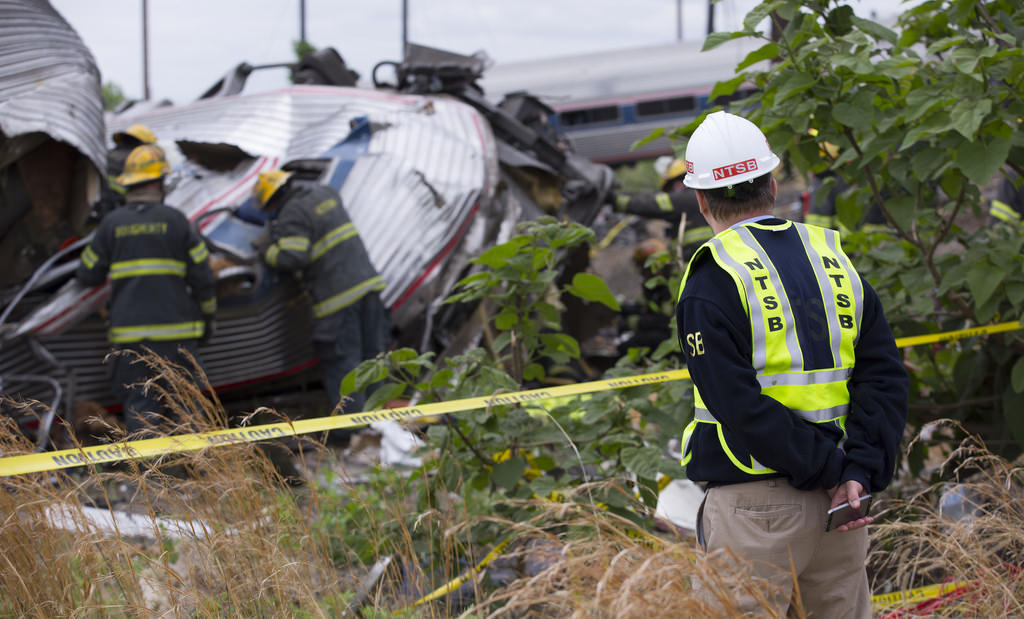
PHILADELPHIA — Amtrak engineer Brandon Bostian has been found not guilty of all charges stemming from the fatal May 12, 2015, derailment of Northeast Regional train 188.
CBS News reports the jury returned its verdict after a little more than an hour of deliberations.
The 38-year-old Bostian was tried on charges of causing a catastrophe, eight counts of involuntary manslaughter — one for each of the passengers killed in the accident — and more than 200 counts of reckless endangerment. The trial came after a convoluted legal path that saw the charges against Bostian dropped and reinstated twice.
The New York Times quoted Bostian’s lawyer, Brian McMonagle, as saying the verdict “gave [Bostian] his future back.
“Brandon made a mistake because of the distraction, and that’s not a crime,” McMonagle said. “I explained to the jury that good people make honest mistakes every day, and it’s not criminal conduct.”
Pennsylvania Attorney General Josh Shapiro, whose office prosecuted the case, said in a Friday statement that his office “respects the jury’s verdict” finding that Bostian’s actions were not criminal.
“There is no question that the excessive speed of the train that the defendant operated resulted in death and injury to his passengers,” the statement said. “Our goal throughout this long legal process was to seek justice for each and every victim, and help bring victims’ families and their loved ones closure.”
KYW-TV reports jurors departed quickly without discussing their decision.
The jury had begun deliberations Friday morning when the judge announced that an alternate would join the panel, replacing a juror whose sister died Thursday night. Deliberations than began anew.
The derailment occurred after Bostian’s train entered a 50-mph curve at more than 100 mph. The National Transportation Safety Board’s accident report concluded that Bostian lost “situational awareness,” at least in part because he was following radio reports of rocks that had been thrown at other trains in the area.
— Updated at 9 p.m. CST with reactions from Bostian attorney, Pennsylvania attorney general.














One thing I learned in transportation, is a single person can make an error or decision that destroys a company.
Several airlines have been victim of this. As have numerous trucking companies.
The weights and forces involved in transportation means continuing vigilance is a necessity. Sleep deprivation, loss of awareness, management failures, in combination can all create disaster.
I wonder if this curve now has a permanent speed restriction. Also, as in airplane crashes, some small alteration far from the accident stream of events, causes an alteration of normal operations. Yet, it goes unnoticed and the effects cascade into something much bigger. I wish the local law enforcement would pay more attention to minor actions by vandals that could have far worse consequences. Blessings
Having to live with the haunting memories of his mistake is punishment enough.
Amtrak should have been charged. Turning off the ATC system on the Northeast Corridor is inexcusable. The system would have prevented the accident. And ATC has been on the corridor since the 1930’s.
That will come up in the civil trial.
What I remember from reading of the signal systems in effect on both approaches to the curve: The new cab signal (ACSES) was never programmed to give a cab signal downgrade from Normal Speed to govern eastbound trains through the curve account the Engineering Department’s “derailing speed” for the curve was/is higher than the TT bulletined speed and no one thought any locomotive engineer would ever accelerate into the curve from the MAS in effect between North Philadelphia depot and the beginning of the curve. Westbound, the approach speed is higher than the “derailing speed” and the system’s cab signal downgrade was in effect that forces the engineer to reduce speed or suffer an automatic emergency brake application.
There is no good outcome to this trial. Guilty, acquitted, it comes out to the same — a horrid train crash and a terrible, lifelong burden for all involved.
For the past years, I myself have lived with my own micro – demon — that it could have been me driving that train, that I am capable of a failure of situational awareness. I’m way too old for railroad employment, but well into my retirement age I still drive a car.
Let me explain. I’m a skilled, cautious and aware automobile driver and take pride in that. But I’m not driving a train. In my Subaru, I decide how fast to drive and when to accelerate or decelerate. It’s my decision to drive within a stopping distance of what’s ahead in the lane. Amtrak NEC engineers are directed to drive fast, to barrel full bore into a curve not knowing what’s on the tracks around the bend – a trespasser, debris on the tracks, another train. Bottom line — Mr. Bostian earned a living by being told to drive faster than he would want to.
This gives me hope in the integrity of our system. No doubt Mr. Bostian have borne his own pain these past years. And, will for the rest of his life. For, he too is a victim of this tagedy. Perhaps Amtrak needs to re-examine running HSR on right-of-way that are almost 200 years old?
The injured victims along with the families and love ones of the deceased are not receiving justice for Mr Bostian’s unprofessional behaviour of distraction. Bostian will live on with the weight of angst from the families and love ones of the injured and deceased.
Juries protect the little man from abuse by our systems of justice, especially in criminal cases. I know from experience that you never forget a tragedy of this nature from my direct involvement with the Lac Mégantic tragedy.
It was a horrible accident to be sure. But in my opinion the jury got it right this time.